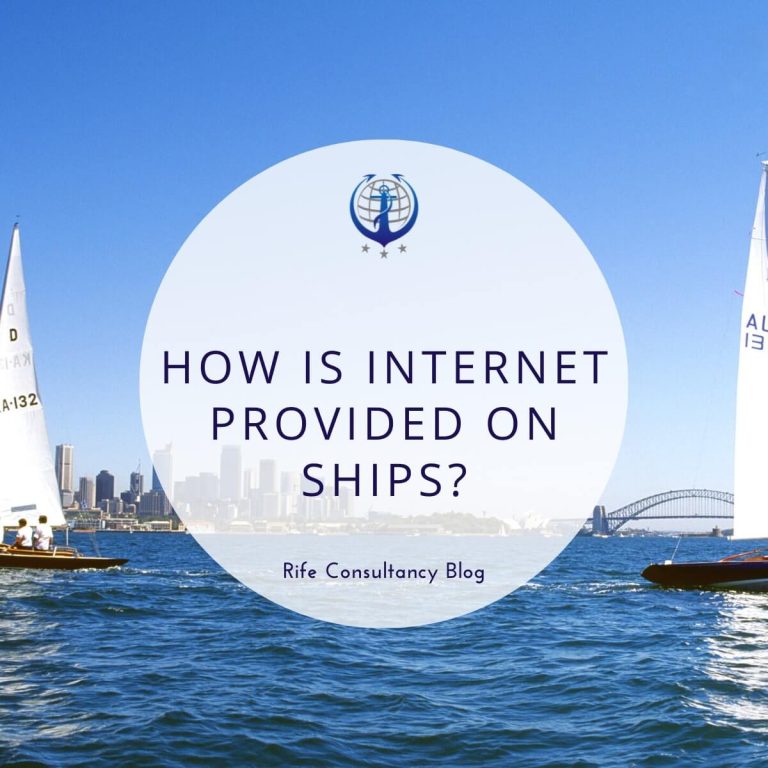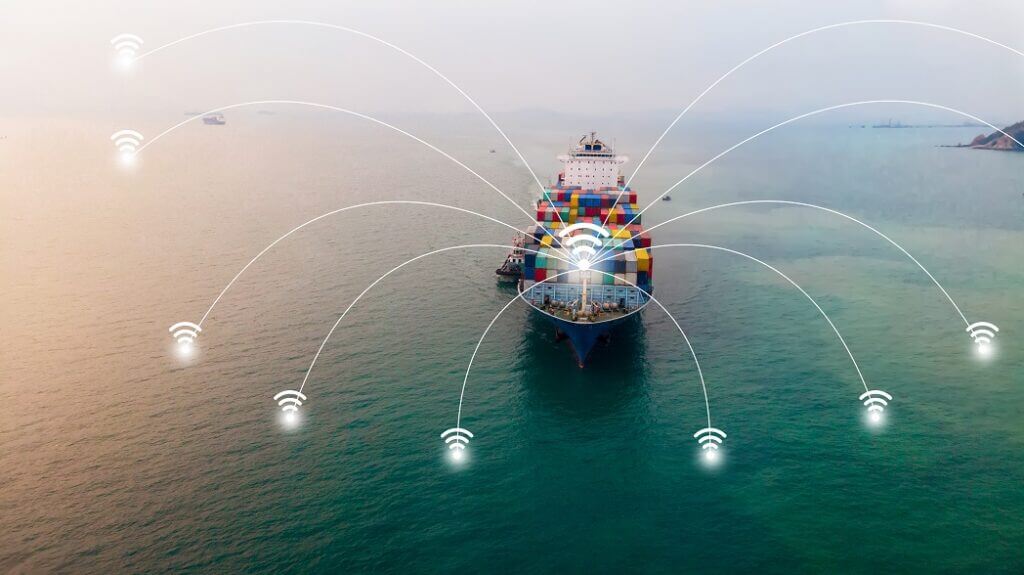
How is Internet Provided on Ships & Cruises?: 9 Things to Know while Sailing
A vacation on ships or cruise lines is preferably a time when you intentionally want to spend away from the craziness of life, which is always dependent on technology and the internet. You would want to disconnect from your phone, fax, email, and everything else that keeps you connected to the outside world and spend some quality time with yourself and your loved ones. But, in today’s real world, it is hard to stay away from accessing the internet, even if it is for a short duration while sailing on ships.
Provide internet on ships is not the same as on the shore, because, well, you are not on land. There are no towers or wires that can easily make marine internet a reality. Nonetheless, humans made it happen! Let’s see how.
Table of Contents
How is Internet provided on ships and cruises?

A decade ago, the true meaning of cruising was to get away from it all – completely unaware of work building up back at the office, no mobiles vibrating with message notifications, no laptops populating the luggage bags. However, times have changed now.
The Internet has become a huge part of our lives and we can’t even imagine going a day without checking our social media networks. With the industry’s top players pouring millions of dollars in communication systems – on land, onboard ships, and in the sky through satellites – more passengers are finding Wi-Fi service and rates more in line with what they’re used to getting on land.
Here’s how internet is provided on ships:
1. Satellite connections
Satellite connections are the most common method of providing internet on ships. Providing a direct connection with the satellite services through some hardware installations on the ship can grant easy access to the internet for people onboard.
Hardware installations are required so that internet signals may be received from any location. Installation fees for the full ship internet might be over $600, with extra fees for hardware ranging from $50 to $100. The choice of hardware depends upon a number of factors like the size of the ship, intended internet usage, desired speed, and cost component.
Many organizations provide a large choice of such equipment, which may assist you in finding exactly what you want. It is a one time investment that allows easy internet access thereon.
There are particular zones on cruise ships that provide internet connections for the guests, allowing them to access their email from anywhere in the globe. Some ships also have designated WiFi zones where everyone can access the wireless internet. However, internet on cruise ships is nothing like the DSL connection you’re used to.
Some providers promise to provide connections with comparable speeds, but they are not the same. Although the speed may be sufficient, additional issues such as connection latency occur in the majority of situations.
Also, using internet on cruise ships is not a cheap option. With internet usage charging anywhere from $.75 to $10 a minute, it is best to utilize it carefully.
2. Wireless devices
Some people prefer to take wireless devices with them on cruise ships to be able to get better internet. However, they don’t seem to work too well. These wireless devices can access internet properly only when the ships are near the port.
Many internet service providers offer data cards that can be connected directly to the system. But, these data cards can also be used when the ships are near the port and the internet signals can be received.
3. Dial ups
Another method of delivering internet access onboard is through mobile phone dial-up connections. This, too, can’t be considered as a reliable option because it is largely reliant on the phone’s signal reception.
In this situation, the phone serves as a modem to connect to the internet via satellite. However, signal loss might reduce its effectiveness.
9 things you need to know about Internet on Ships
In the upcoming years, improvements in internet will be seen on more cruise ships. However, there will always be some kind of unreliability – especially when you sail farther out in the deep waters.
If you’ve ever growled in anger as your screen froze in the middle of an email or are nervous about not being able to check-in as frequently as you’d want on an upcoming cruise vacation, here are the 9 things you need to know about Internet on ships.
1. Internet on ships is not the same as your broadband at home
From the current technological standpoint, it is a fact that the internet on ships will not be the same as the one that we use at our homes and offices. The large golf ball-shaped domes seen on the tops of cruise ships are protective shells that house freely moving satellite antennas.
The antennas transmit signals from the ship to a satellite and the satellite then sends a signal back to the ship’s antenna. Maritime communication firms have speed up this process by adding additional satellites, boosting the bandwidth that can be transferred during each transmission, and connecting to land-based towers while sailing near the shore.
However, the most common obstacle to reliability remains the lack of a clear path between the ship and the satellite. This pathway must be traversed by all data transferred from the ship to the satellite and back (for example, pages loading on a browser).
To make a connection, the antenna must be pointed at the satellite and have an unobstructed line of sight to it. However, the path between the antenna and the satellite might get obstructed at times.
Congestion inside the path might also create an issue in connectivity. As more people use their laptops and mobile phones to access data, congestion can build up – causing passengers to experience slower speeds.
2. Cost of internet on ships can be very high
The satellites used for establishing internet connections on ships cost millions of dollars. It is not possible for a single cruise line to install satellites but they are collaborating with marine companies that either own their satellites or rent large amounts of bandwidth that can bring the average costs down.
So, how much can you expect to spend on the internet on cruise ships? Traditional onboard prices for internet are about 75 cents per minute. You can also purchase packages offering anywhere from 60 minutes to 300 hours that work out to be cheaper on a price-per-minute basis.
Internet packages are becoming increasingly common, with either a fixed daily charge or a predetermined price per voyage based on the number of days. Carnival Cruise Line, for example, offers a Social Package starting at AU$36 for a three-night cruise, a Value Package starting at AU$54 for a three-night cruise, and a Premium Package starting at AU$78 for a three-night cruise.
3. Use these techniques to surf internet on ships
If you don’t like slow internet, the best thing to do is to use the internet when there are less number of people online. Late light hours and when the ship is at the port are the best times in this case. Using internet late at night is better, especially while sailing far out in the sea, because the fewer people online sharing limited bandwidth, the faster the connection will be.
Also, when the ship is at port or sailing near the shore, they switch to terrestrial (land-based) towers, which will help you get better internet access. It will be much faster and if you pay by the minute, you will get more bang for the buck. It will save you time & money. Unfortunately, there is nothing more than this that you can do as an individual cruiser.
Again, the quickest and inexpensive connection will always be onshore, and for those who only want to check in on their house, utilizing free Wi-Fi in port with your smartphone may be the best option.
4. Don’t expect quality streaming
Video calls and social media are ideal for staying in touch with family, colleagues, or clients, but who wouldn’t like to catch up with a favorite show on Netflix? However, as we already mentioned, the internet bandwidth is very limited on ships. Also, most ships either block these programs entirely to alleviate the bandwidth or have a connection so sluggish that they are unusable.
There are currently only a few ships that offer adequate bandwidth to passengers to stream Skype, Facetime, Netflix, and other OTT platforms. Such ships also charge a premium amount for providing access to these streaming services.
5. Turn your mobile phones off
Because the caller is being billed by two firms, mobile phones are a particularly easy method to build up high costs very rapidly. The satellite provider deploys a mini-cell tower onboard the ship and charges for the transmission of your voice to the satellite and back down to land. Furthermore, your mobile phone provider imposes a roaming fee.
While you may not notice a distinct line in your bill statement from the satellite provider, rest assured that it is going to be cut. In order to lower down the cost further, keep a tab on incoming text messages. If possible, keep your phone on airplane mode and avoid using the network provided by the ship to download messages.
Data fees might be very high while roaming on a mobile network. So, if you don’t carry your laptop and want to use your mobile to check messages or surf the web, you are better off utilizing the ship’s Wi-Fi. Simply turn off your phone’s ability to access mobile signals and keep the Wi-Fi ability active. For smartphone users, the best idea is to find a free Wi-Fi connection ashore and surf the internet free of cost.
6. Save money by saving mobile data on board
The cruise ship has its own cellular network antenna, which activates once you are a few miles offshore. There are several strategies and techniques for saving mobile data, but data is continually being used in the background. As previously stated, roaming rates are more costly when onboard a cruise ship.
Thus, you need to make sure that your mobile data is turned off. In case you are vacationing with children, check their mobile data settings on a regular basis. There have been stories of kids mistakenly turning on mobile data usage, and their parents were astonished by the large phone bills when they returned from vacation. So, better be safe than sorry!
7. Cruise ships are finding ways to improve internet connectivity
Some cruise ship firms are working hard to enhance their internet connection and have developed a few optimization techniques for better internet at sea. Crystal Cruises spent a lot of money to increase its connection speed, and it’s a wonderful example of what other cruise lines should do.
A sophisticated gadget determines which websites are the most popular. Those frequently visited webpages (Facebook, Newspapers, etc.) are saved offline. This allows the webpage’s skeleton to load significantly faster before it has to connect to the internet.
As a result, this data is not requested each time a passenger visits the website, but rather is already stored. This results in a much faster page loading time. Crystal also employs a package shaper, which prioritizes specific types of traffic. According to the cruise lines, passenger internet is given first priority, with 80% of overall bandwidth capacity dedicated to them.
8. Take advantage of Wi-Fi calling
If you have the feature of Wi-Fi calling on your phone, then consider using it. If the internet connection onboard is fast enough, you will be able to utilize Wi-Fi calling to phone or text someone onshore without using the cellular network.
You must understand that Wi-Fi calling is not an app. It is a feature available on your smartphone. You simply need to go to your phone settings and turn it on. Using that, you can make and receive calls from areas with no coverage. Any WiFi network can be used for WiFi calling, either a free or paid WiFi connection. If you are using your own phone data you only need to enable WiFi calling. However, if your phone doesn’t have that function you can always download an app.
9. Find free Wi-Fi on ports
Every once in a while, the cruise ship will make a stop at the port. It will provide you with a chance to go out and explore and also find free Wi-Fi options. If you ask the crew members where you can get access to free WiFi, they will gladly assist you with the same. Alternatively, you can also ask locals while walking around in the city. This way, you will be able to surf the internet and connect with your family/colleagues without paying anything.
In a Nutshell,
Internet is provided by communicating with a satellite by an antenna on the cruise. The antennas transmit signals from the ship to a satellite and the satellite then sends a signal back to the ship’s antenna.
The marina’s (or other neighboring hotspots) wireless system is the cheapest, but not necessarily the easiest, option to access Wi-Fi onboard. Directly connecting your phone or laptop to it is fine, but you will frequently struggle to get a decent connection, especially below deck.
P.S. Just in case you are interested in working on ships/cruise ships, we can help! Just contact us at Rife Consultancy to know whether you are eligible for joining the Merchant Navy!
Click here to join our Telegram chanel
You will get information, news, and support related to Merchant Navy.
